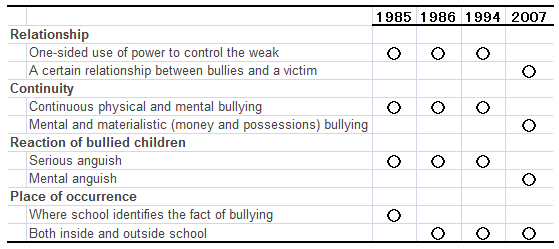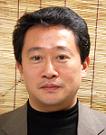Anatomy of Child Bullying in Japan
- 1. Definition of Bullying and Its Transformation (This article)
- 2. Bullying in Different Cultures - Differences and Similarities in Bullying Between Countries
- 3. Bullying and the Relation to Teacher Leadership
- 4. Bullying Prevention (1): Preventing Bullying Caused by "Negative Conformity"
- 5. Bullying Prevention (2): Preventing the Escalation of Bullying by Recognizing Children's SOS Signs
- 6. Bullying Prevention (3): How to Interpret the Anti-Bullying Act
- 7. Bullying Prevention (4): What Should We Expect from Bullying Prevention Programs?
- 8. Bullying Prevention (5): Bullying Prevention Program by the Tokyo Metropolitan Government
- 9. What Does the Number of Bullying Reports Imply? An Analytical Study Based on Data from across Japan
- 10. Anatomy of Child Bullying in Japan 10: Effects of the broader definition of bullying
Definition of Bullying and its Transformation
Today, there is a general consensus that bullying is a menace that must be detected and eradicated. However, such a concept was instantiated quite recently, and it was more common until the late 1980s for people to think that bullying was the rite of passage from childhood to adulthood. To put it the other way around, bullying was not yet a serious problem in our society at that time. A series of tragic stories of victims of bullying have, however, changed the public opinion on bullying in Japan.
One can begin with the case of Hirofumi Shikagawa who was in his second year of junior high school in Tokyo when he committed suicide in February 1986 after repeated bullying from his classmates. As many of you may not know about the incident, I will briefly explain it here. It was reported that he was forced to run errands and constantly beaten and tormented by his classmates. His father noticed the state of his son, and complained to those children bullying his son and to their parents. This intervention was effective for a while, but over time the bullying worsened. Eventually, the bullies started the game of "ignoring his existence".
It was a morning of November 1985 when the bullies conducted a mock funeral ceremony for Shikagawa. His classmates and even four teachers including his supervising teacher wrote messages on a mock condolence card, thinking it was just a joke. He must have despaired at being treated as person, in school, who did not exist. The bullying escalated thereafter, and on February 1, three months after the mock funeral, Shikagawa was found hanging in the public toilet at Morioka Station, Iwate Prefecture. He left a note with the names of classmates who had tormented him. He wrote, "I don't want to die yet, but my life is a living hell. I am going to kill myself, but I don't want someone to become the victim after I die, otherwise my death would be meaningless. Please stop this stupidity."
Since there had been frequent incidents of bully-related suicides before Shikagawa's case, the then Ministry of Education, Science, Sports and Culture took preventive measures and officially published the definition of bullying in 1985. The public criticism of bullying was not yet strong at that time; however, Shikagawa's tragic story has shocked the society, which has led to the conceptual emergence of banning bullying.
It was the case of Kiyoteru Okouchi that triggered a public uproar and shaped public opinion that bullying was absolutely wrong and unacceptable. Okouchi was the second grader of junior high school in Aichi Prefecture and killed himself in 1994, about ten years after Shikagawa's suicide. Okouchi had badly suffered from bullying, being extorted by his classmates almost every day. The number of bully-related suicide deaths peaked in 1985, 1995, and 2005. It is still unknown why the peak occurs every decade, but the Ministry of Education, Culture, Sports, Science and Technology (MEXT) changed the definition of bullying at each peak time (Table 1).
From 1985 until 1994, three factors of "inequality of power", "continuity" and "anguish" were fundamentally needed to be in place to recognize the existence of bullying; however, in 2007, the government eliminated the two factors of "inequality of power" and "continuity" from the definition of bullying and focused on the factor of "anguish" only. In other words, "bullying is considered to be occurring when a child is conscious of being bullied": this, as a result, widened the scope of definition of bullying.
Table 1 Changes in the definition of bullying by the Ministry of Education/MEXT

Those second-year junior-high school students at that time of Shikagawa's incident (1985) are now 41 years old. Is there any change in the actual conditions of bullying since then?
Changes in the style of bullying
The characteristics of bullying have gradually changed since around 1985, the year the mock funeral ceremony was conducted for Shikagawa. Before 1985, bullying used to occur in the form of abuse which targeted a specific child over a relatively long time. Public opinion, newspapers and other mass media tended to think that bullied children might have had something wrong with them that triggered bullying. Shikagawa had to endure such a situation. At that time, many people still had memories of a time of violence, scarcity and endurance in the Second World War, and thus thought "Bullying was much worse before than it is now" or "Bullied children must have something wrong with them to be a victim of bullying". However, after 1985, the style of bullying has changed to that of bullies going from one child to the next victimizing them for a short time, and gradually people came to think that it was the practice of bullying which should be banned.
The growing cases of bullycide have prompted people to become more aware of the seriousness of bullying. In the past, adults would be relatively unconcerned when they observe teasing or fighting between children, believing that this was simply a part of their growth process and children knew when to pull back. Even if there was bullying in primary/junior high school, adults would think children were clever enough to know how to set a "boundary," which they had learnt through group activities: the ability to set boundaries is an attribute considered to differentiate between human and animal behavior. Therefore, when some children started to kill themselves as a result of bullying, Japanese society was shocked and recognized that there was something missing in children's behaviors, and that conventional notions of bullying were no longer valid.
There may be various reasons why the style of bullying has changed from that of bullies preying upon a specific child for a long time to that of bullies going from one child to the next, victimizing them for a short time. One possible reason may be that public opinion towards bullying has changed (now considered as evil), which inhibits bullies from targeting a specific child for a long time. Or it could be the reaction of children who are forced to live in today's educational environment that focuses on equality and ignores the intrinsic value of biological diversity. Since the introduction of "equal education", schools avoid conflicts and rivalry among children and prohibit ranking in competitive sports. Considering such circumstances, it may be natural to think that children voluntarily seek individual differences and diversity by identifying a person to bully. Or the change in bullying reflects today's child-centered society where strong relationships are more difficult to develop than previously, due to the increasingly tenuous nature of human relations. Without a sense of camaraderie, it is difficult for bullying children to target a specific child for a long time.
Furthermore, it became apparent that the mode of group bullying has declined while individual style bullying has emerged since 1995. Impulsive behavior is more often shown by delinquent juveniles, and school violence is more often seen between individual children. Group-based bullying is more obvious among girls than boys, in which they use relational aggression like ignoring or ostracizing a victim. According to data in 1995, boys tend to physically abuse someone directly such as breaking the personal belongings of a victim, while girls tend to give "silent treatment" such as isolating and ignoring an individual: this kind of bullying is difficult for others to notice. However, since around 2003, the cases of group bullying and relational aggression (ignoring and isolation) by boys and girls decreased, in particular, the cases of boys; while the cases of direct aggression increased. As such, the mode of group bullying has shifted to individual-style bullying.
In sum, I have discussed a brief background of bullying trends in Japan: changes in the holistic view of society on bullying, changes in the definition of bullying by the MEXT according to the changing public view, and changes in the style of bullying. In the next report, I would like to explain the characteristics of bullying in different cultures.
Related article



 Dr. Sugimori is Professor of Social Psychology at Tokyo Gakugei University, conducting research on group psychology (evaluation of team working, psychology in the citizen judge system, and effects of experiential activities) as well as risk psychology, from the standpoint of cultural social psychology focusing on social relations between individuals and groups. He also serves as Board Member of the Japanese Society for Law and Psychology; Executive Board Member of the Society for Field-Culture Education; Board Member of the Youth Friendship Association; Councilor of the Outward Bound Japan; Researcher of the Center for Research on Educational Testing; Board Member of the Children Institute for the Future, Tokyo Gakugei University; Chairman of the Accreditation Committee, Japan Association for Certifying and Training Educational Specialists.
Dr. Sugimori is Professor of Social Psychology at Tokyo Gakugei University, conducting research on group psychology (evaluation of team working, psychology in the citizen judge system, and effects of experiential activities) as well as risk psychology, from the standpoint of cultural social psychology focusing on social relations between individuals and groups. He also serves as Board Member of the Japanese Society for Law and Psychology; Executive Board Member of the Society for Field-Culture Education; Board Member of the Youth Friendship Association; Councilor of the Outward Bound Japan; Researcher of the Center for Research on Educational Testing; Board Member of the Children Institute for the Future, Tokyo Gakugei University; Chairman of the Accreditation Committee, Japan Association for Certifying and Training Educational Specialists.










